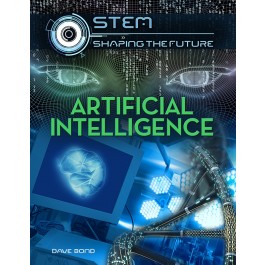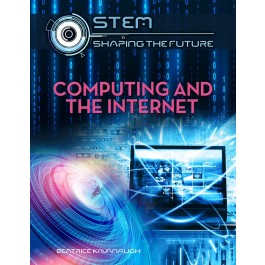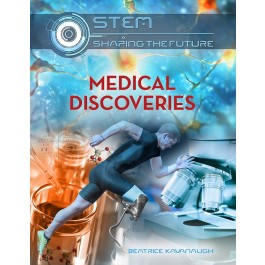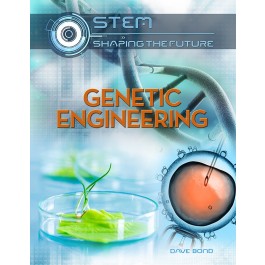STEM: SHAPING THE FUTURE

3
2017
12+
7th - 12th
7 x 9
Booklist Review
Far more people are involved in modern medicine compromises than just doctors and nurses. Laboratory technicians, researchers, chemists, and even policy makers are all part of this comprehensive entry in the STEM: Shaping the Future series, that examines how modern science drives healing. A graphic-rich layout alerts readers to research projects, terms, QR code-compatible on-line resources, and comprehension questions in the sidebars. Unlike typical STEM-based resources, this interactive book focuses on the intersection of science and moral quandaries, and includes ethical discussions on genetic testing, fertility and abortion, and end-of-life dilemmas. Additionally, the text also includes a look at the ways that laws and policies are created to keep pace with medical discoveries. Most readers will be surprised at the far-reaching connections modern medicine makes, even outside traditional STEM realms.SLJ Review
Readers curious about the current innovations and future possibilities of four high-interest STEM fields will find plenty to consider in this thoughtful collection. Each volume examines developments in research as well as the ethical questions raised by continued scientific and technological advancements, doing so in an impartial and fair way that encourages students to draw their own conclusions. Easy-to-understand language will appeal to report writers and casual readers alike, while photos and diagrams support and extend the detailed information. VERDICT First-rate nonfiction for teens.by Dave Bond
| Hardcover | ISBN 978-1-4222-3711-3 | $24.95 | Add To Cart |
| eBook | ISBN 978-1-4222-8073-7 | $31.95 | Add To Cart |
Artificial intelligence (AI) is a term used for computers that can think for themselves, communicate, and act in some of the same ways as human beings. Today computers have become “smarter” than ever before, with AI machines capable of diagnosing medical conditions, driving cars, and detect fraud and criminal activity. However, despite these and other positive uses for AI, not everyone is excited about the potential benefits of this technology. Some people fear that continued development of artificial intelligence will result in a dystopian society ruled by machines. Others believe that AI can liberate people from repetitive, menial tasks and improve the quality of human life. This book will examine developments in AI research, and explore some of the questions that improvements in artificial intelligence technology raise.
Each title in this series includes color photos throughout, and back matter including: an index and further reading lists for books and internet resources. Key
Icons appear throughout the books in this series in an effort to encourage library readers to build knowledge, gain awareness, explore possibilities and expand their viewpoints through our content rich non-fiction books. Key Icons in this series are as follows: Words to Understand are shown at the front of each chapter with definitions. These words are set in boldfaced type in that chapter, so that readers are able to reference back to the definitions--building their vocabulary and enhancing their reading comprehension. Sidebars are highlighted graphics with content rich material within that allows readers to build knowledge and broaden their perspectives by weaving together additional information to provide realistic and holistic perspectives. Educational Videos are offered in chapters through the use of a QR code, that, when scanned, takes the student to an online video showing a moment in history, a speech, or an instructional video. This gives the readers additional content to supplement the text. Text-Dependent Questions are placed at the end of each chapter. They challenge the reader’s comprehension of the chapter they have just read, while sending the reader back to the text for more careful attention to the evidence presented there. Research Projects are provided at the end of each chapter as well and provide readers with suggestions for projects that encourage deeper research and analysis. And a Series Glossary of Key Terms is included in the back matter containing terminology used throughout the series. Words found here broaden the reader’s knowledge and understanding of terms used in this field.
by Beatrice Kavanaugh
| Hardcover | ISBN 978-1-4222-3712-0 | $24.95 | Add To Cart |
| eBook | ISBN 978-1-4222-8074-4 | $31.95 | Add To Cart |
Since it became widely available for public use in the early 1990s, the Internet has proven to be amazingly useful for facilitating communication, distributing information, and sharing knowledge. Human society has already been changed by the Internet—and as new technologies develop, even more opportunities will be available to people online. However, some people have concerns about technology and privacy, the availability of new technology to everyone, and whether information shown on the web might it influence people or cultures in a negative way. This book will look at the role that the Internet and computer technologies play in society, and consider some of the questions that are raised by its development.
Each title in this series includes color photos throughout, and back matter including: an index and further reading lists for books and internet resources. Key Icons appear throughout the books in this series in an effort to encourage library readers to build knowledge, gain
awareness, explore possibilities and expand their viewpoints through our content rich non-fiction books. Key Icons in this series are as follows: Words to Understand are shown at the front of each chapter with definitions. These words are set in boldfaced type in that chapter, so that readers are able to reference back to the definitions--building their vocabulary and enhancing their reading comprehension. Sidebars are highlighted graphics with content rich material within that allows readers to build knowledge and broaden their perspectives by weaving together additional information to provide realistic and holistic perspectives. Educational Videos are offered in chapters through the use of a QR code, that, when scanned, takes the student to an online video showing a moment in history, a speech, or an instructional video. This gives the readers additional content to supplement the text. Text-Dependent Questions are placed at the end of each chapter. They challenge the reader’s comprehension of the chapter they have just read, while sending the reader back to the text for more careful attention to the evidence presented there. Research Projects are provided at the end of each chapter as well and provide readers with suggestions for projects that encourage deeper research and analysis. And a Series Glossary of Key Terms is included in the back matter containing terminology used throughout the series. Words found here broaden the reader’s knowledge and understanding of terms used in this field.
by Beatrice Kavanaugh
| eBook | ISBN 978-1-4222-8076-8 | $31.95 | Add To Cart |
Medical science is advancing all the time. Researchers are constantly trying to find new ways to help people to have long and healthy lives. Thanks to their work, doctors today can cure diseases, lessen pain, replace unhealthy limbs or organs, and help infertile couples have children. Doctors can even keep seriously ill people alive against all odds. But not everyone is enamored with advances in medicine. They question whether it is appropriate to prolong life in all cases, or believe that certain treatments have been developed unethically. This book will look at how the ways that doctors treat the sick are developed, and examine some of the questions that are raised by advances in medical science.
Each title in this series includes color photos throughout, and back matter including: an index and further reading lists for books and internet resources. Key Icons appear throughout the books in this series in an effort to encourage library readers to build knowledge, gain awareness,
explore possibilities and expand their viewpoints through our content rich non-fiction books. Key Icons in this series are as follows: Words to Understand are shown at the front of each chapter with definitions. These words are set in boldfaced type in that chapter, so that readers are able to reference back to the definitions--building their vocabulary and enhancing their reading comprehension. Sidebars are highlighted graphics with content rich material within that allows readers to build knowledge and broaden their perspectives by weaving together additional information to provide realistic and holistic perspectives. Educational Videos are offered in chapters through the use of a QR code, that, when scanned, takes the student to an online video showing a moment in history, a speech, or an instructional video. This gives the readers additional content to supplement the text. Text-Dependent Questions are placed at the end of each chapter. They challenge the reader’s comprehension of the chapter they have just read, while sending the reader back to the text for more careful attention to the evidence presented there. Research Projects are provided at the end of each chapter as well and provide readers with suggestions for projects that encourage deeper research and analysis. And a Series Glossary of Key Terms is included in the back matter containing terminology used throughout the series. Words found here broaden the reader’s knowledge and understanding of terms used in this field.
by Dave Bond
| Hardcover | ISBN 978-1-4222-3713-7 | $24.95 | Add To Cart |
| eBook | ISBN 978-1-4222-8075-1 | $31.95 | Add To Cart |
Genetic engineering, and related research, is helping to shape the future of humankind. Over the past two decades scientists have made impressive breakthroughs. They have used the technology to discover cures for diseases, solve crimes, and develop drought-resistant crops that can be used to feed millions of people. However, not everyone is excited about the potential benefits of this technology. Some people believe that it is not right for scientists to “interfere” with nature; others are concerned about unknown health issues related to genetically modified organisms. These are difficult but intriguing ethical issues. This book will examine the science behind genetic engineering, discuss how scientists work with and modify genetic information, and explore some of the questions this new science raises.
Each title in this series includes color photos throughout, and back matter including: an index and further reading lists for books and internet resources. Key Icons appear
throughout the books in this series in an effort to encourage library readers to build knowledge, gain awareness, explore possibilities and expand their viewpoints through our content rich non-fiction books. Key Icons in this series are as follows: Words to Understand are shown at the front of each chapter with definitions. These words are set in boldfaced type in that chapter, so that readers are able to reference back to the definitions--building their vocabulary and enhancing their reading comprehension. Sidebars are highlighted graphics with content rich material within that allows readers to build knowledge and broaden their perspectives by weaving together additional information to provide realistic and holistic perspectives. Educational Videos are offered in chapters through the use of a QR code, that, when scanned, takes the student to an online video showing a moment in history, a speech, or an instructional video. This gives the readers additional content to supplement the text. Text-Dependent Questions are placed at the end of each chapter. They challenge the reader’s comprehension of the chapter they have just read, while sending the reader back to the text for more careful attention to the evidence presented there. Research Projects are provided at the end of each chapter as well and provide readers with suggestions for projects that encourage deeper research and analysis. And a Series Glossary of Key Terms is included in the back matter containing terminology used throughout the series. Words found here broaden the reader’s knowledge and understanding of terms used in this field.






















